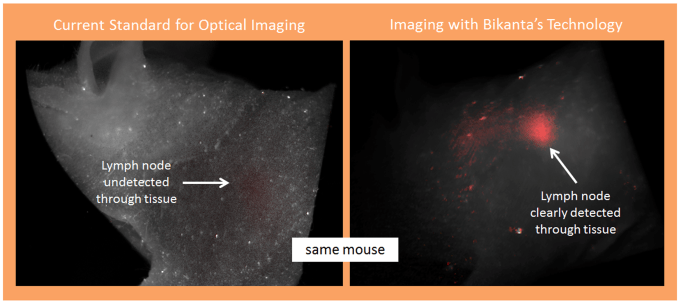Y Combinator-backed biotech company Bikanta wants to find and stop cancer at its source by inserting tiny, fluorescent diamonds inside your body. The brainchild of Dr. Ambika Bumb, who holds a PhD in biomedical engineering from Oxford, these nanodiamonds can detect molecular abnormalities at a much earlier stage, essentially stopping cancer from spreading any further.
Bumb was working on her first post-doctoral fellowship with the National Institute of Health (NIH) at Oxford University when she became dissatisfied with current limitations for cancer screening. Current methods are unable to detect small tumors or breakaway tumor cells that lead to something called micrometastatic tumors, which can go undetected at the source and lead to the spread of cancer throughout other areas of the body. Bumb also points out the technical limitations involving signal loss, high background interference and unacceptable toxicity that have sidelined research endeavors. Quantum dots (one of the two other fluorescence/optical imaging agents) are made of CdSe/Cds/ZnS core materials that are toxic, for example.
According to the World Health Organization (WHO), cancer rates around the world are expected to rise 57 percent over the next 20 years. That would mean cancer diagnoses would rise from an estimated annual total of 14 million to 22 million. Small or breakaway tumors go undetected each year, leading to unnecessary death. This is all because current methods don’t allow us to see them when they form.
This need for better methods of finding disease at the source has also led to a $3.5 billion market in optical imaging reagents. In other words, the market is huge for creating better fluorescent dyes, nanodiamonds and other things used to light up the insides of your body. The market could be worth up to $5 billion by 2017, according to BCC Research.
There’s also the challenge of un-mixing fluorescent signals from the background. Tools used to light up the molecular abnormalities, such as fluorescent dyes and quantum dots, are very limited in helping to literally highlight this problem. Fluorescent dye doesn’t give off any light if the molecular structure is different, for instance.
This is where the nanodiamonds come in. Bumb discovered that crushing up essentially imperfect diamonds into dust created a fluorescent, reflective light that could highlight any molecular abnormality. “It’s like having a flashlight inside your body that basically lasts forever,” says Bumb. This is also a breakthrough method not currently available in the market.

Nanodiamonds have an additional magnetic sensitivity property that can be used to resolve this issue. Initial tests revealed the signal-to-background ratio was improved in vivo by 100-fold with the fluorescent nanodiamonds. And, says Bumb, there is potential for even greater reduction of background noise with more testing. The technology has so far been used to visualize lymph nodes that were invisible in conventional imaging.
Beyond cancer detection is an even bigger potential here — precise, hands-free surgery. These nanodiamonds may one day be able carry cancer-destroying technology along with it. Unlike conventional nanodiamonds that form into clusters, Bikanta’s nanodiamonds remain separate but stable in liquid suspension, and they can be tightly bound to any targeting agent (e.g. aptamers, antibodies). This means Bikanta could create designer drugs with the diamond material that would effectively detect specific diseases. So, just as the nanodiamond material searches through the body to find molecular abnormalities, it also gets rid of them at that very moment.
“My thought is, if every doctor helps ten patients a day, engineers who create technology employed by a hundred doctors can help one thousand patients a day,” says Bumb.
